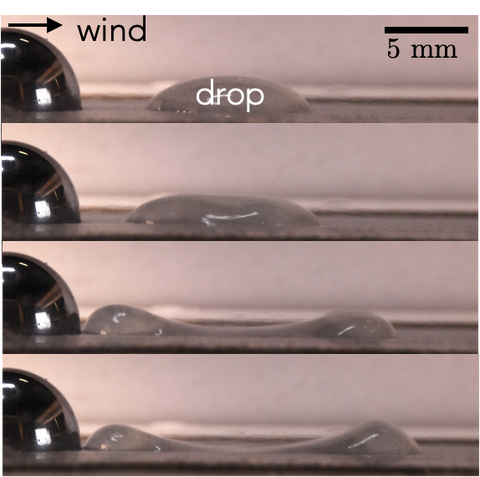Funded by NSF-CBET (Fluid Dynamics), we investigated the dynamics of a partially-wetting droplet under high-Re wind, by combining wind-tunnel experiments and mathematical modeling. In particular, to simulate the interaction of partially-wetting droplets in wind, we placed a partially wetting droplet behind a solid protuberance inside a wind tunnel. The results show that the droplet exhibits three different behaviors depending on its size and distance from the solid: depinning downstream, depinning upstream, and splitting. In addition to experiments, we rationalized the onset of the upstream regime by considering a quasi-static droplet model in a wake. More recently, we conducted a series of experiments in which we applied a jet of air normal to the partially-wetting droplet on the surface. Our experimental results show that the droplet can remain pinned or undergo splitting before dislodging off the surface, depending on the jet velocity. In collaboration with Prof. Mike Shelley (NYU), we developed a 2D lubrication model of the drop subject to a stagnation point flow and predicted the critical wind speed for splitting, in good agreement with the experiments.
A. Hooshanginejad*, C. Dutcher, M. Shelley and S. Lee, “Droplet breakup in a stagnation-point flow,” Journal of Fluid Mechanics (2020) 901, A19
https://doi.org/10.1017/jfm.2020.560
A. Hooshanginejad* and S. Lee, “Droplet depinning in a wake,” Physical Review Fluids (2017) 2, 031601(R) (published as a Rapid Communication - priority dissemination of important new results)
https://doi.org/10.1103/PhysRevFluids.2.031601
Building from our previous results, we are currently collaborating with Prof. Satish Kumar (UMN) to incorporate the moving contact line into our lubrication model. Our improved droplet model will include a precursor film and disjoining pressure, to capture the contact line dynamics in a stagnation point-flow.
